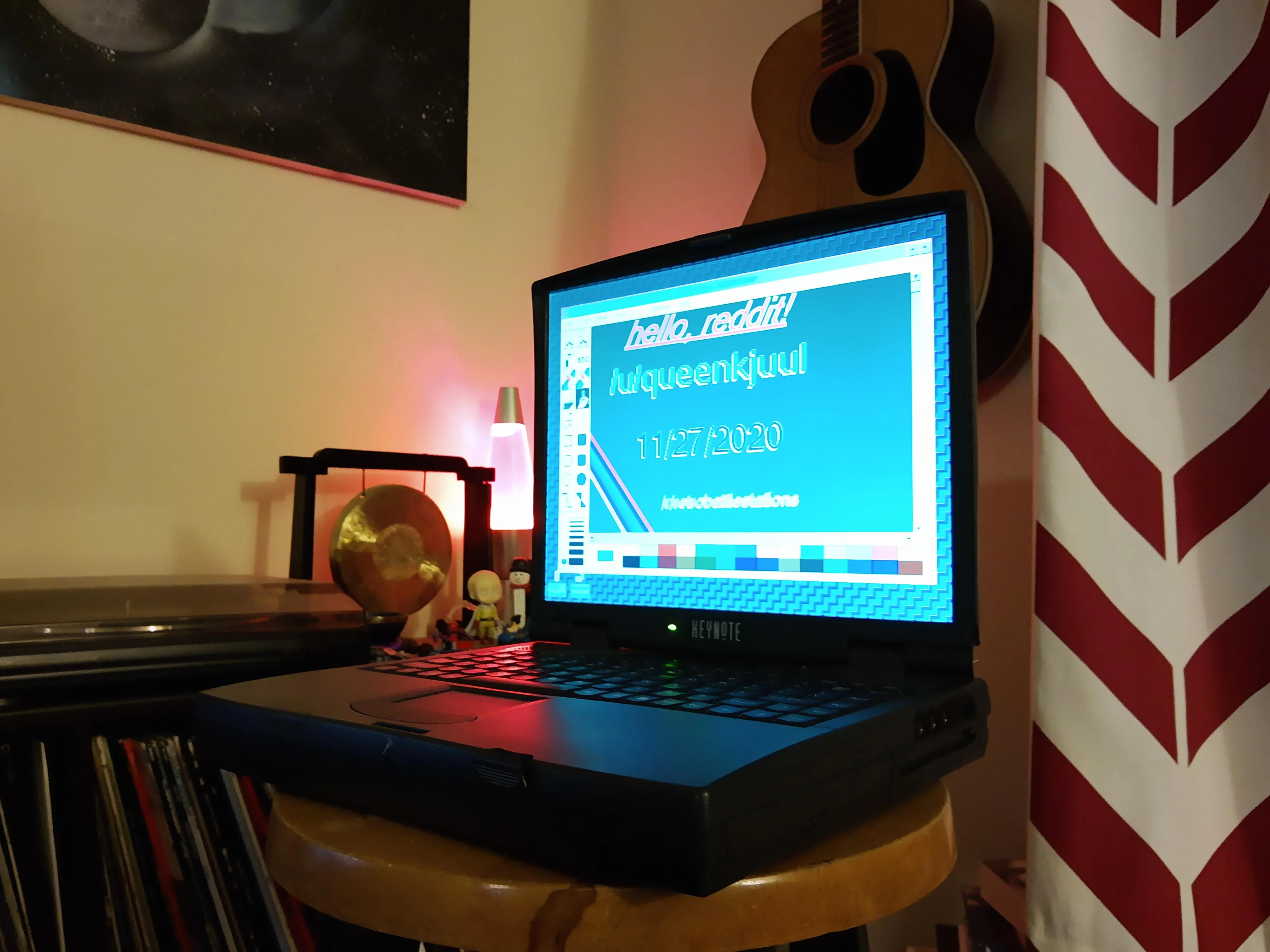Yes, Keynote…. My adventures with a vintage laptop
Somewhere near the start of the outbreak of COVID-19 in the United States, so approximately 15 years ago today as of October 2020, I made an impulsive decision to buy a 20 year old computer on eBay. This computer has been, like all good computers should be, a source of great frustration and joy. It’s occupied more of my time than just about anything else as I’ve been trapped at home alone these last many months. It’s honestly a pretty fantastic machine, and I really can’t wait to tell you about it. First, though, I need to tell you about this other machine.
Two months ago I bought a laptop for $20. All I knew about it was that it was working well enough to boot into Windows 95, and that it was therefore at least 20 years old. The brand, as far as I could tell, did not exist: “Keynote Laptop” found me nothing but pictures of Steve Jobs and Tim Cook standing on stages. I eventually found the only reference to Keynote brand that I’ve ever been able to find, which is the incredible magazine advertisement pictured above. I found it alongside the next image, which actually pictures the precise model that I own. While the two models look the same, the specs in each ad differ: one indicates a Pentium II 400 and a 15” screen, the other indicates “Intel or AMD’s latest–Including Tillamook!” and a 14.1” screen. Tillamook was the Intel codename for the “mobile module” form factor which housed the Pentium MMX series of CPUs.

Nightmare Fuel
I met the person, bought the computer, and took it back to my car. Eager to inspect the thing, I opened up the screen, which all looked good. On the back, there was a flip-down cover which snapped into place over the I/O ports. I snapped this cover down and leaned forward to get a look at back panel. When I saw what was there, I screamed, closed the back panel door, and set the computer on the floor next to me.
Maggots. Dead maggots. This computer, which had recently been on the seller’s kitchen counter in the photos on the listing, was chock full of dead maggots. I was rightly horrified.
I put the thing in a plastic grocery bag, wrapped it up, and left it in the trunk of my car for the next several weeks.
Eventually, I worked up the courage to take another look at the thing. And also borrowed a shopvac from a friend. I’m not gonna dwell on this part because to this day sometimes I look at this thing and shudder and wish I’d torched it instead of rescuing it. Yet rescue it I did, and I spent hours and hours laboring over this thing. A whole tube of Clorox wipes later and I’m comfortable saying that every single millimeter of this machine has been thoroughly disinfected. I took apart every single thing, and I mean every single thing. This computer has never been in that many pieces since before it was built, and it likely won’t again. I disassembled the CD and floppy drives and even broke into the battery casing. It’s as clean as it could possibly get.
it was worth it
This is actually a pretty incredible machine. The build quality is excellent, the keyboard feels better than any laptop keyboard I’ve used in the last five years, and the components are all modular. The floppy drive and the battery are the same size, so you could run with two batteries instead. The battery, floppy drive, and CD drive all pop out with the press of a button, the hard drive is immediately accessible beneath the flip-up palmrest, and with the hard drive compartment opened up the keyboard simply lifts out freely, exposing the two RAM sockets.
The specs are top notch for its day, too, with a Pentium MMX at 233MHz, 32MB of PC100, 2 Cardbus PCMCIA slots (including an aftermarket 56k modem, lucky me!), a 2GB hard drive, and an XGA screen. The graphics are driven by a Chips and Technologies (yes, really, also sometimes seen as just “CHIPS” or C&T) 65555 chip that can push 1024x768 at 16 million colors, and strangely enough offers composite video input and output, though unfortunately I’ve been unable to track down the software to make that work. In addition to the composite video output, the machine has a standard VGA output as well.
What excited me most, though, was when I discovered the sound chip, which was a genuine Yamaha OPL3-SAx. I had done a fair bit of research already on Windows 98-era Creative cards, and I recognized the OPL3 as the AdLib synthesizer chip, which my Sound Blaster Live! could attempt to emulate, but did not have in hardware.

